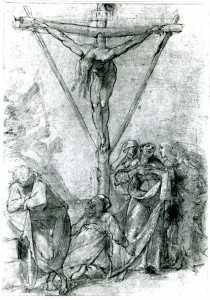Haarlem, Teyler Foundation, no. A x 80.
Pen and brown ink, brown wash, black and red chalks, heightened with white, on paper tinted with pink wash, 27.9 x 19.3. Inscribed in pencil in the upper left corner: 25; the upper left corner of the verso inscribed in pencil: 24.
PROVENANCE (from Christina Queen of Sweden, 1966): Sandrart. Queen Christina of Sweden. Azzolino, Duke Livio Odescalchi.
LITERATURE:
Triomphe du Maniérisme, 1955, 139, no. 245, Pl. 42, as Rosso, probably before 1516.
Theodore Rousseau, Jr., “The Triumph of Mannerism?,” Art News, LIV, 5, September, 1955, 21, Fig., as Rosso.
Barocchi, 1958, 235-236, as Rosso.
Berenson, 1961, no. 2442C, as Rosso.
Carroll, 1964 (1976), II, Bk. II, 489-490, F. 33, Bk. III, Fig. 185, as by Pellegrino Tibaldi, around 1549.
Hauser, 1965, II, Pl. 68, as Rosso (but wrongly as in the Uffizi).
J.Q. van Regteren Altena, Les Dessins italiens de la Reine Christine de Suède, Analecta Reginensia II, Stockholm, 1966, 97, as Rosso.
Christina Queen of Sweden, exh. cat., Nationalmuseum, Stockholm, 1966, 452, 1101, as Rosso.
Graphically and figuratively, this Crucifixion bears no relation to drawings certainly by Rosso. It is very likely that the drawing is by Pellegrino Tibaldi. The handling of it is virtually identical to that of his Conception of St. John the Baptist at Windsor Castle (Fig.Windsor, Tibaldi).1 The Teyler drawing is also stylistically similar to Tibaldi’s Nativity, dated 1549, in the Borghese Gallery, Rome.2 The drawing was exhibited at the Morgan Library in New York in 1989 as “now plausibly attributed to Pellegrino Tibaldi around 1550.”
Leo Steinberg kindly pointed out to me that the figure of Christ appears in the etching Christ Crucified Between Two Thieves by C P (Bartsch, XIX, 1821, 183-184, 1),3 a monogram identified at the Albertina as that of the Bolognese Giovanni Pietro Possenti (Fig.Crucifixion).

